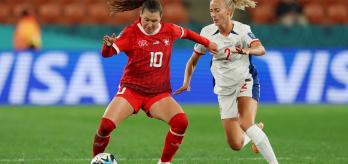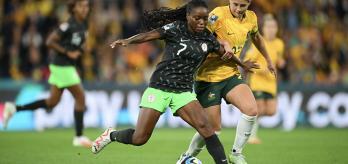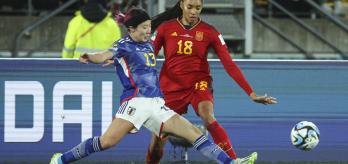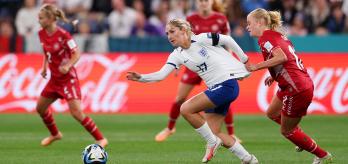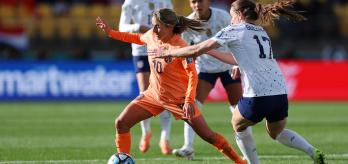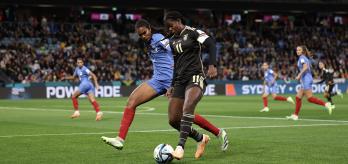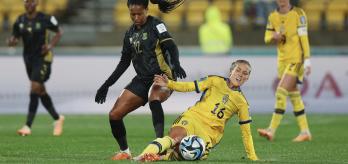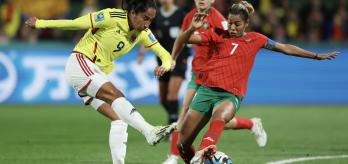The Netherlands topped the table after their impressive 7-0 victory over Vietnam in matchday three. Second place remained on a knife-edge until the final whistle of USA v. Portugal, where a point from their goalless draw was enough to see the USWNT progress. One of Group E's highlights was a repeat of the final at FIFA Women's World Cup 2019™ with the Netherlands facing the USA; the cagey tactical battle in Wellington ended in a 1-1 draw.
Netherlands
Gemma Grainger: The Netherlands dominated possession in all three of their group games. They used a back three in possession, while the midfielders and forwards looked to offer to receive the ball in spaces in central positions in midfield to break lines. They played to their strengths in possession, and were helped by the high level of technical ability in their squad, which meant they were confident enough to move the ball forward, happy to receive the ball under pressure, and well-equipped to play in an expansive attacking shape. They were clinical in front of goal, too, scoring nine goals in the group stage.
Defensively, the Dutch were organised and compact, using a high-energy counter-press to regain possession or force the opposition to play the ball backwards. They conceded just once in the group stage, from a set piece in their second game against the USA.
USA
Nadine Angerer: In possession the USA built up in a 4-3-3. The full-backs positioned themselves slightly higher up the pitch, while the centre-backs strove to play to their forward players and often break the first two lines of the opposition in the process. Left-back Crystal Dunn (19) was also a focal point in the US build-up play during the group stages. Lindsey Horan (10) would often drop into deeper pockets to receive the ball and progress the play.
Central midfielder Andi Sullivan (17) played an important role in balancing her team's defensive structure and would start games mainly by playing safe, short passes to her team-mates. As games went on, Dunn and Horan would look to penetrate the final third by playing passes in behind the opposition's defensive line or passing the ball to attackers positioned in between the lines of the opposition.
The USA adopted a 4-5-1 formation in an aggressive mid and high-block when out of possession. At times, their defence failed to work as a team, which gave the opposition space between the attacking and midfield lines.
This USA team has a selection of outstanding individual players such as Sophia Smith (11) and Horan; players of this quality can score any second. Nevertheless, so far the USA have lacked the cohesion that we have seen from them in previous years.
Portugal
Clémentine Touré: Portugal play in a 3-4-1-2 and/or 3-4-3 system. The players have excellent technical qualities, which means they are good on the ball and good in possession.
The team builds its game on targeted attacks and wing play, with Diana Silva (16), Jessica Silva (10), and Francisca Kika (20) all involved. Their attacks are built from the back with passes out of the defence to Ana Borges (9) or Diana Gomes (19), after which the ball progresses through midfield through combinations, good passing and triangles. Dolores Silvia (14) often plays a key role in building attacks, while her fellow midfielders support the attack and are in the thick of the action in front of goal.
In defence, Portugal take up position in a high and/or median block and use a zonal marking system. They are careful to stay close together and close down the space for the opposition.
In attacking transition, they look to attack quickly and play the ball inside, waiting for a player to make a run to the near post. Portugal are strong in possession and in set pieces, and have a fine goalkeeper in Inês Pereira. On the other hand, they have been inefficient in front of goal, and have struggled to move the ball quickly through midfield.
Vietnam
Kirsty Yallop: Vietnam's back-five was organised and well implemented. Throughout the group stages their defence remained compact and connected, making it relatively hard for teams to play freely in Vietnam's defensive third. They often made sure they had strong numbers in their own box when defending. This prevented their opposition from creating any clear-cut chances and pressured opposition attackers whenever they were trying to get a shot off.
Goalkeeper Thanh Trần (14) was a key player. She was extremely brave, came out and challenged on all set plays and aerial balls in the box. She made many crucial saves throughout all three games.
Vietnam's midfield four did not appear to be as cohesive and the shape was a bit inconsistent which would allow teams to play between the lines and in behind the midfield. The midfield players would step out aggressively to apply pressure and almost appeared to be man-marking at times. This would allow large spaces for teams to play through and around in central areas.








